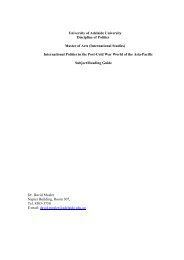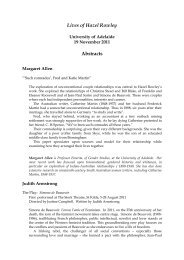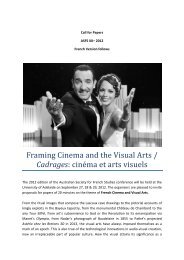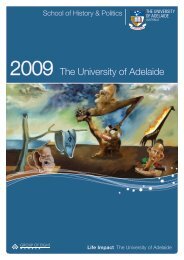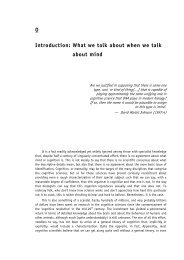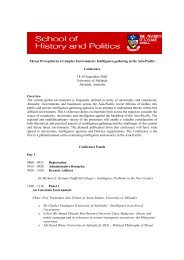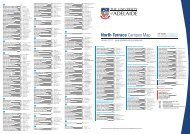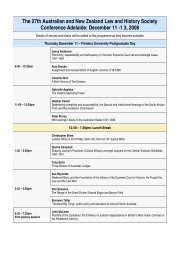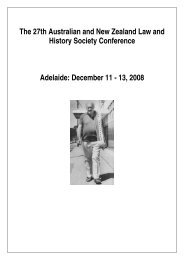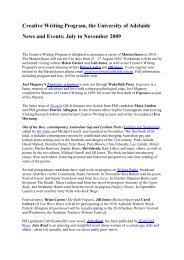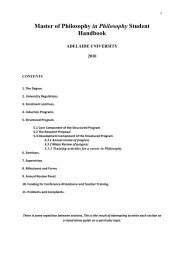Biohumanities - Paul Griffiths - Representing Genes
Biohumanities - Paul Griffiths - Representing Genes
Biohumanities - Paul Griffiths - Representing Genes
You also want an ePaper? Increase the reach of your titles
YUMPU automatically turns print PDFs into web optimized ePapers that Google loves.
March 2008 “SCI-PHI” SYMPOSIUM<br />
39<br />
engaging with the science at the same level<br />
as practitioners rather than via popular<br />
representations. But the broad visions of<br />
science in which it results can be expressed<br />
in a nontechnical way, and can thus make<br />
a major contribution to the public’s understanding<br />
of science.<br />
The remaining sections of the paper will<br />
give more substance to these remarks with<br />
two specific examples of research in which<br />
we have participated: the <strong>Representing</strong><br />
<strong>Genes</strong> Project and the Innateness Study.<br />
Section 1 uses these projects to highlight<br />
the new field of experimental philosophy<br />
of science and to introduce the ideas of<br />
scientific concepts as “tools” for research<br />
and the experimental philosopher of science<br />
as a “conceptual ecologist.” Section 2<br />
provides an example of how constructive<br />
criticism of research in molecular and developmental<br />
biology can lead to the formulation<br />
of a new vision of “postgenomic biology.”<br />
In Section 3, we examine the role<br />
of biohumanities as a critical communicator<br />
of scientific results and scientific practice<br />
to wider audiences. We hope that<br />
these examples all point toward a new and<br />
fruitful relationship between the humanities,<br />
biology, and society.<br />
1. Experimental Philosophy of<br />
Biology as Conceptual Ecology<br />
The new field of “experimental philosophy”<br />
(X-phi) brings empirical work to bear<br />
on philosophical questions. We have been<br />
involved in two X-phi projects. The first<br />
focused on changing concepts of the gene.<br />
Previous research established that it is possible<br />
to operationalize questions about the<br />
gene concept in a survey instrument completed<br />
by researchers, and hence to examine<br />
the prevalence of particular gene concepts<br />
in different biological fields (Stotz et<br />
al. 2004). The <strong>Representing</strong> <strong>Genes</strong> Project<br />
was an extension of that earlier work (Stotz<br />
and <strong>Griffiths</strong> 2004). The next section<br />
briefly describes the <strong>Representing</strong> <strong>Genes</strong><br />
Project, concentrating on the methods<br />
used (for our more substantive discussion<br />
of the project’s findings about the gene<br />
concept, see <strong>Griffiths</strong> and Stotz 2006,<br />
2007).<br />
The second X-phi study focused on the<br />
much disputed concept of innateness. <strong>Griffiths</strong><br />
and collaborators examined which<br />
features of behavior lead biologically naïve<br />
individuals to label behaviors “innate.”<br />
They used their findings to explain the<br />
persistent controversies over the definition<br />
of innateness. We outline this work in Section<br />
1.2.<br />
1.1 the representing genes project<br />
This project was an attempt to assess the<br />
impact of the ongoing genomics revolution<br />
on concepts of the gene (Stotz et al.<br />
2006; Stotz and <strong>Griffiths</strong> 2004; see also<br />
http://representinggenes.org). The actual<br />
practice of genome annotation inspired us<br />
to design a simple, annotation-like task for<br />
part one of our survey instrument. This was<br />
used to investigate the criteria that lead<br />
biologists to annotate a particular DNA sequence<br />
as either one gene with several<br />
gene products or several genes with a single<br />
functional product. We used graphical<br />
representations and descriptions of real<br />
DNA transcription events in eukaryotic genomes<br />
to illustrate the features of genome<br />
expression that make it difficult to define a<br />
gene in a way that covers all known cases.<br />
Since common definitions of the gene are<br />
insufficient, the simplified annotation task<br />
is designed to reveal the additional implicit<br />
criteria that biologists draw upon when applying<br />
the term “gene.”<br />
Another part of the survey instrument<br />
set out to investigate whether, as Lenny<br />
Moss has argued, investigators either start<br />
with the conception of a gene defined by<br />
its predictive relationship to a particular<br />
phenotype (Gene P), or with the conception<br />
of a concrete gene with a specific molecular<br />
sequence and the template capacity<br />
to code for many different products, depending<br />
on how it is transcribed and how<br />
its initial product is later processed (Gene<br />
D) (Moss 2003). We argued that these different<br />
starting points would affect how investigators<br />
set out to unravel the complex<br />
relationship between genes and other molecular<br />
factors with the phenotype. The<br />
second task asked subjects to assess the<br />
value of different research strategies for



